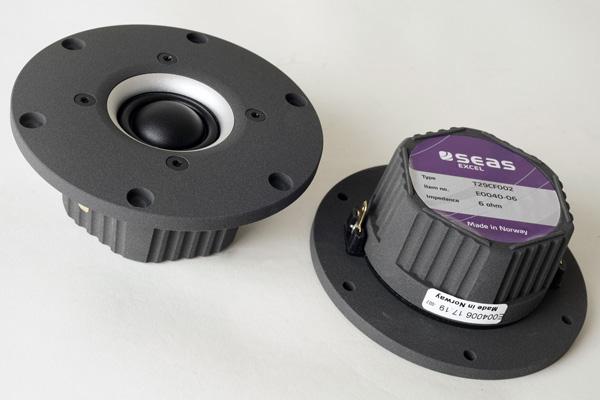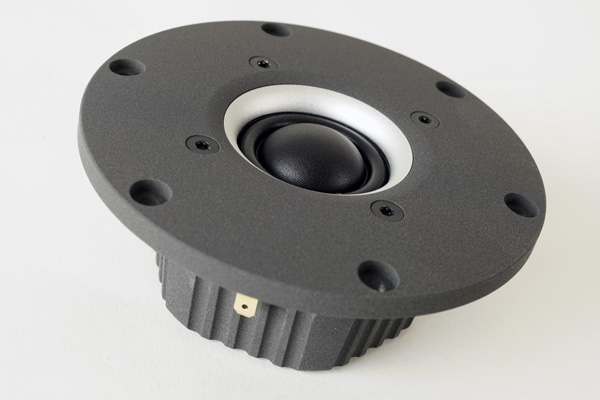SEAS CNO-4
Copyright 2023 © Troels Gravesen
Go to on this page:
DRIVERS
CROSSOVER
CABINET
MEASUREMENTS
SPEAKER-KIT
CROSSOVER LAYOUT
PASSIVE XOVER FOR BASS
Oct. 2023:
After launch of the updated W22NY001, the
edge coated W22NY003, this
driver will now be the default 8" midbass driver. Due to increased Qm,
improved dynamics, more power handling, better frequency response. See
data sheet below.
In addition to the improved TS data, the drivers are now colour matched.
The CNO-4 basic kit will from now on consist of T29CF002, W18NX003,
W22NY003 and BMS 12N630. As always you can buy the kit with/without
drivers - or some of the drivers - and you can mix the drivers without
any changed to the crossover.
CNO-4 is featuring a new 6" and 8" driver from SEAS,
W18NX003
and
W22NY003, an up-date of my beloved
Nextel coated drivers, but here refined with new and improved magnet
systems and titanium voice coil formers. The center pole piece has a
conical boring focusing the magnetic field and reducing stray field.
Center pole piece is copper clad in its entire length,
thus better SD producing flatter impedance profile. The titanium voice
coil former enhance power handling and ensures better cooling of the W18/22
voice coils, thus reduced distortion at high levels, i.e. better dynamic
headroom.
For bass there was no doubt. The BMS 12N630. I've used this bass driver
before in many constructions and it gives incredible value for money.
When I first set up the CNO-4 test cabinets, I was using a vintage SEAS
bass driver, the 33 F-WK-A, a magnificent 13" bass driver, but long
extinct. SEAS doesn't have anything in this range at present, so BMS it
must be.
T29CF002 tweeter.
Can't add much to what I've said before about this dome. One
of the best dome tweeters, in particular with a Amber-Z capacitor in front, but Alumen-Z takes you 99% there.
I want to reiterate that the W18+W2 runs in a 2½-way fashion - with no
high-pass filter. This means the W18 gets the full signal from the
deepest bass up to it's point of crossover. Not having a high-pass
filter to the upper section has its indisputable benefits in terms of improved sonics -
and also saving a considerable amount of money on high-quality
capacitors. It adds some extra strain on the W18 driver in particular,
but with the new titanium voice coil former, it can handle a lot of
power.
There's an option to further improve power handling by adding a high-pass
filter before your power amplifier running the upper section, please
read here:
http://www.troelsgravesen.dk/High-Pass-Filter.htm
Adding a 1st order high-pass filter at ~80 Hz reduce the power input at
40 Hz by 6 dB! This makes a difference in power handling, but for most
applications it may not be necessary.
Having two drivers sharing the upper-bass and midrange means quite some
membrane area, so they never work too hard and even without the
high-pass filter I can play louder than any visitor like without
distortion from the W18 driver. This titanium voice coil formers does
well!
Being very similar to my Ellipticor-3 speakers, my expectations were
under control for the first listening tests. Little had I expected the level
of transparency, crispness and dynamics I heard. Even the bass from the
twin-drivers were surprisingly vibrant, deep and solid. This could be a
candidate for a standard floor-stander 2½-way if the upper panel tilt
and chamfering is kept intact. But please do not ask. Not just a matter
of leaving out the BMS.
Since I received the new W18NX003 drivers they'd been sitting in my
CNO-25 speakers, so they were well broken in when I moved two of them to
the CNO-4 cabs. I loved what they did in CNO-25, but it wasn't until the
CNO-4 set-up that I could fully appreciate the qualities of
this new driver. Installing the speakers in our living room I initially
didn't think them as efficient as I had expected - only to find out I
was playing them louder than normal! A very good sign of low distortion.
The W18NX... has all the qualities I could ask for from a 6" driver.
Utterly transparent and dynamic combined with an overall smooth response
that doesn't make it selective on recordings, nor favour any musical
genre.
Treble? I've had the question on some of my 1st order tweeter set-ups.
Where's the tweeter? Is there really enough treble level because I can't
"hear" the tweeter. No, we can't hear the tweeter, we only hear treble
without phase distortion and the overall tuning as fairly linear. It can
take some mental adjustment, because "1st order treble" sounds quite
different to treble passed through any higher order crossover. Again,
the T29 is a magnificent tweeter and does very well with 1st order
filters.
With the BMS 12N630 driver in place and run by the powerful 500 watts Hypex
501 we have a full-blown full-range speaker delivering a solid
foundation for all kinds of music.
There will be a fully passive options as I know some people will want
this, but only for bi-amping. My recommendation is the Hypex FA501 to
explore the CNO-4 to its full potential.
So, to summarise, what you need to do to get the very best from this
speaker is placing a small capacitor in front of your power amplifier,
take the signal from the speaker wire and use the appropriate software
for the FA501 - and you're flying. The FA501 program will compensate for
the 1st order roll-off and thereafter provide the low-pass filter for
the bass driver. Here's an
illustration of what is happening.
I think I can guarantee an
extraordinary performance.
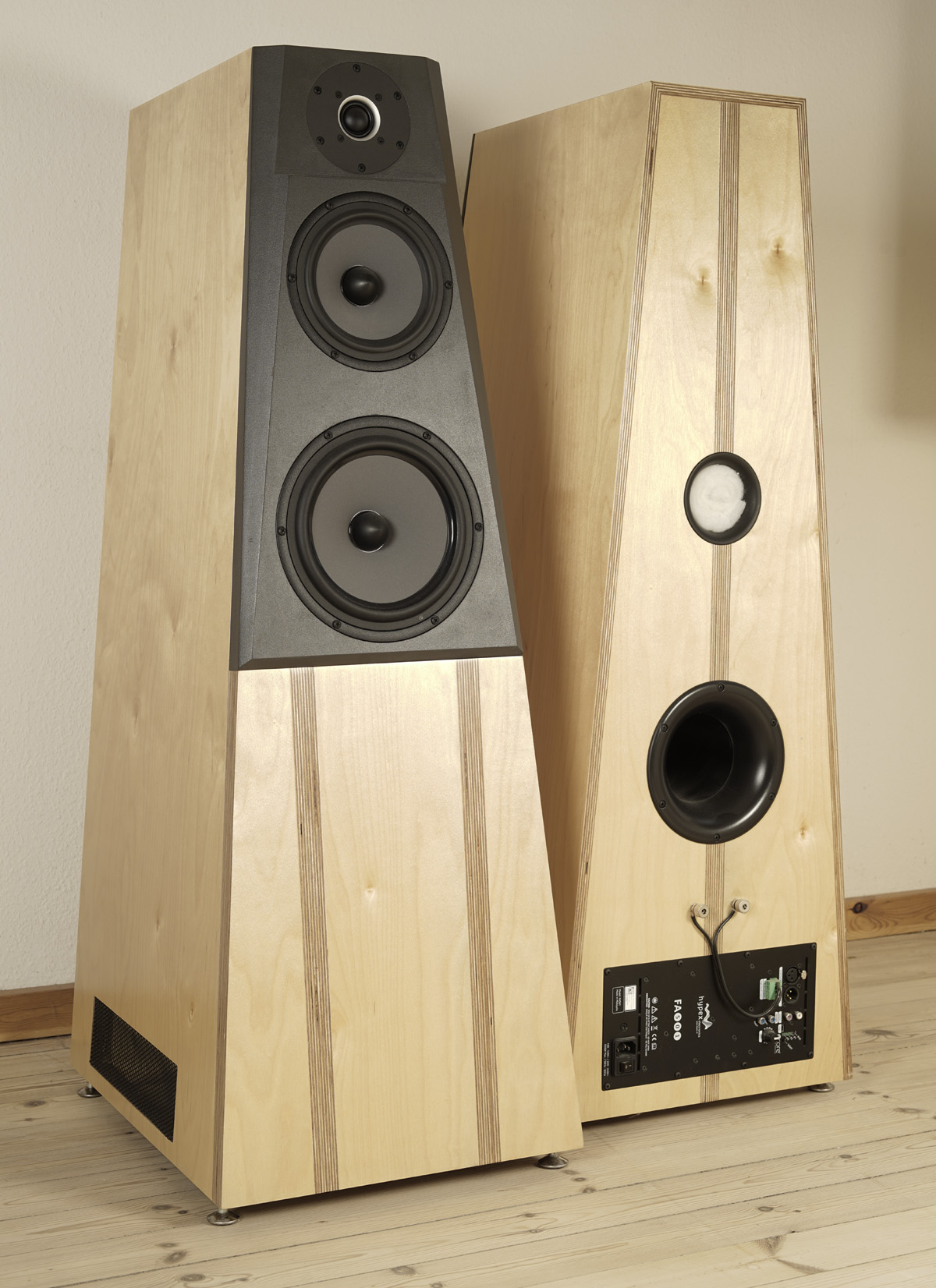
CNO-4, with the new W22NY003, 8" bass driver.
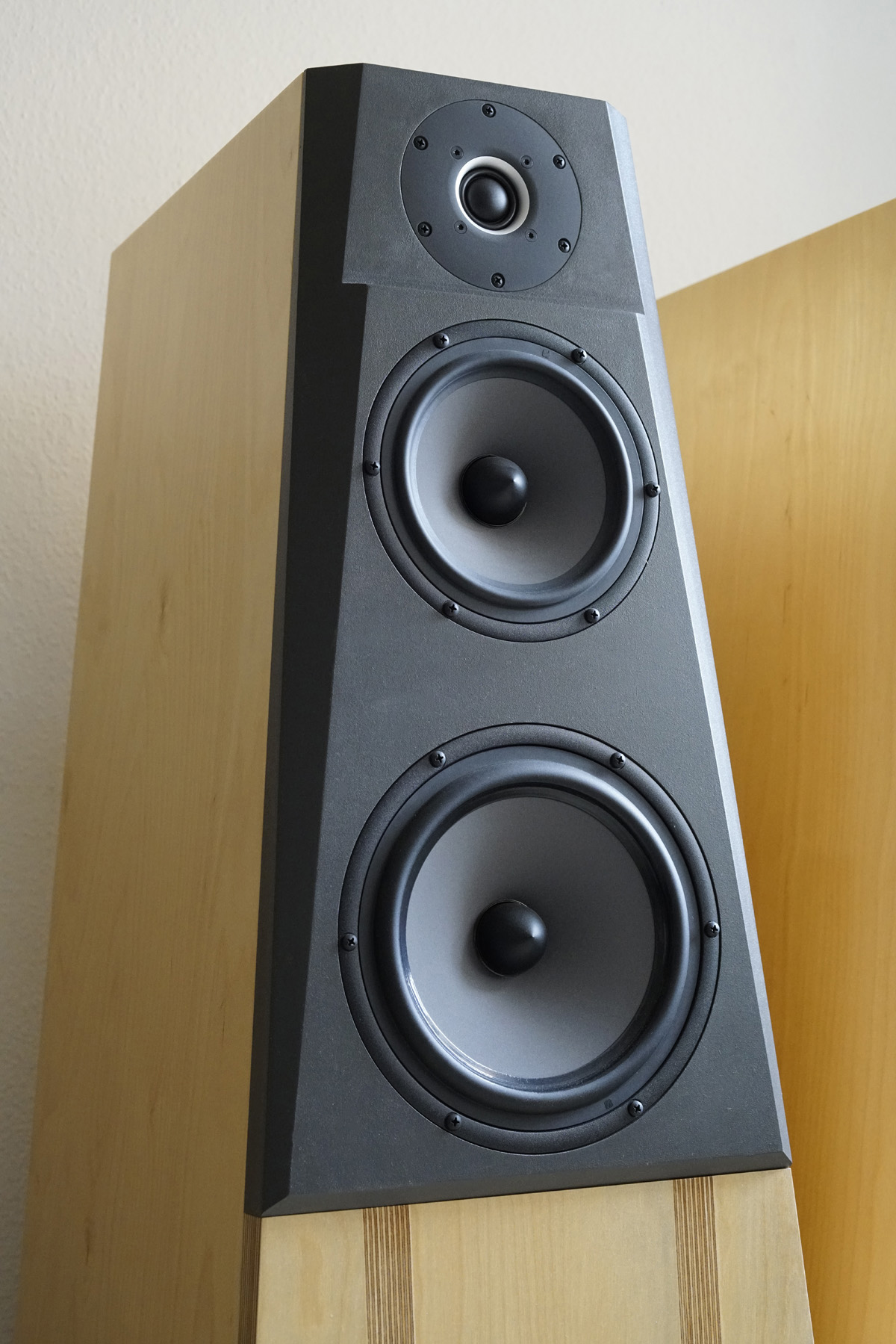
Above the CNO-4 in natural daylight.
Basics:
4-driver speaker.
Dimensions: 39 x 53x 110 cm, WxDxH.
System sensitivity: 91.5 dB/2.8V/1 meter.
Impedance: 4-8 Ohms for MMT section.
Point of crossover: 80 and 2600 Hz.
Power requirement: 20+ watts/channel.
Power handling: 100 watts. Please
also read:
http://www.troelsgravesen.dk/power-handling.htm,
and remember any burned driver is a misused driver.
Useful links (Please
follow all links before e-mailing!):
http://www.troelsgravesen.dk/tips.htm
http://www.troelsgravesen.dk/tips.htm#CONSTRUCTION_OF_CROSSOVERS
http://www.troelsgravesen.dk/crossovers.htm
http://www.troelsgravesen.dk/LCR-RC.htm
http://www.troelsgravesen.dk/Inverted-Polarity.htm
http://www.troelsgravesen.dk/choices.htm
http://www.troelsgravesen.dk/power-handling.htm
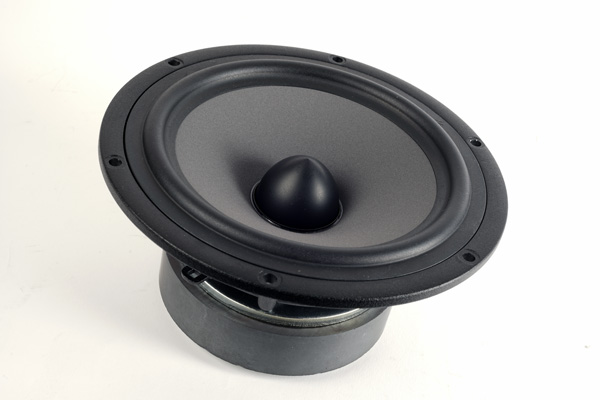
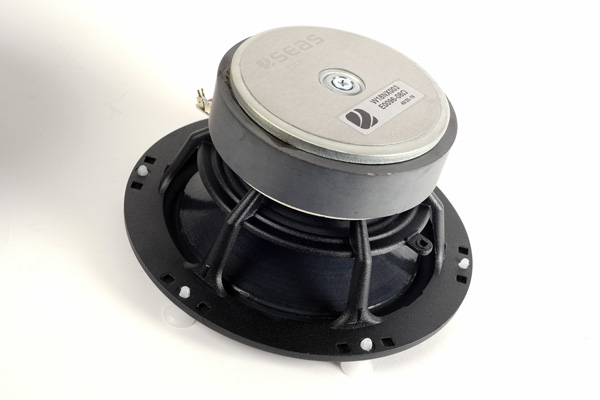
W18NX003, 8 Ohms
Click images to view large

Conical boring of center pole piece, full length copper cladding,
titanium voice coil former (increased power handling), bigger magnet.
Significant increase in Qm = less loss = improved dynamics.
Significantly reduction of voice coil inductance from 0.43 mH to 0.12 mH
= flat impedance curve.
Check out the data sheets and compare.
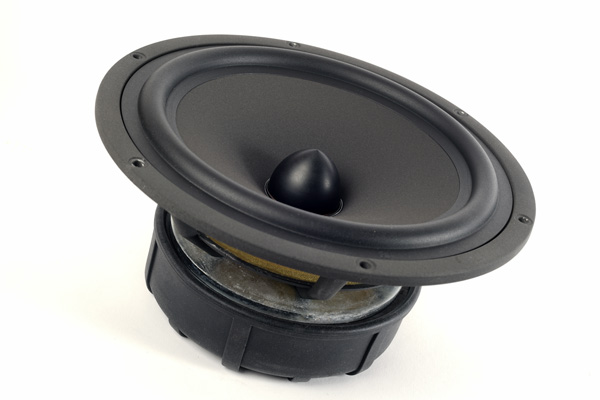
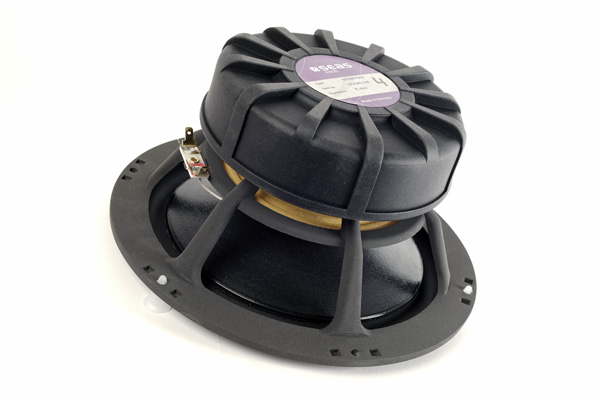
W22NY001, 8 Ohms, now replaced by W22NY003.
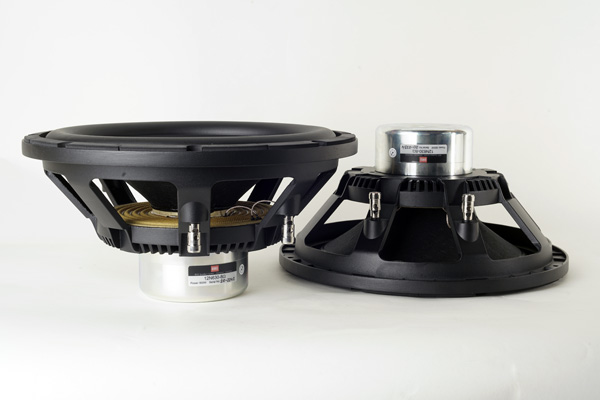
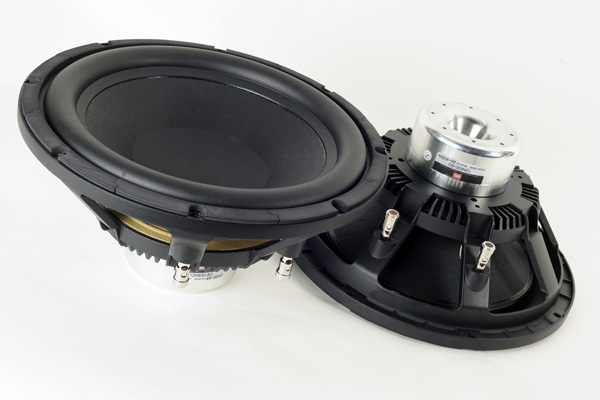
BMS 12N630, 8 Ohms
Click images to view large
Download driver specs:
T29CF002
W18NX003
W22NY003
BMS 12N630
(8 Ohms)
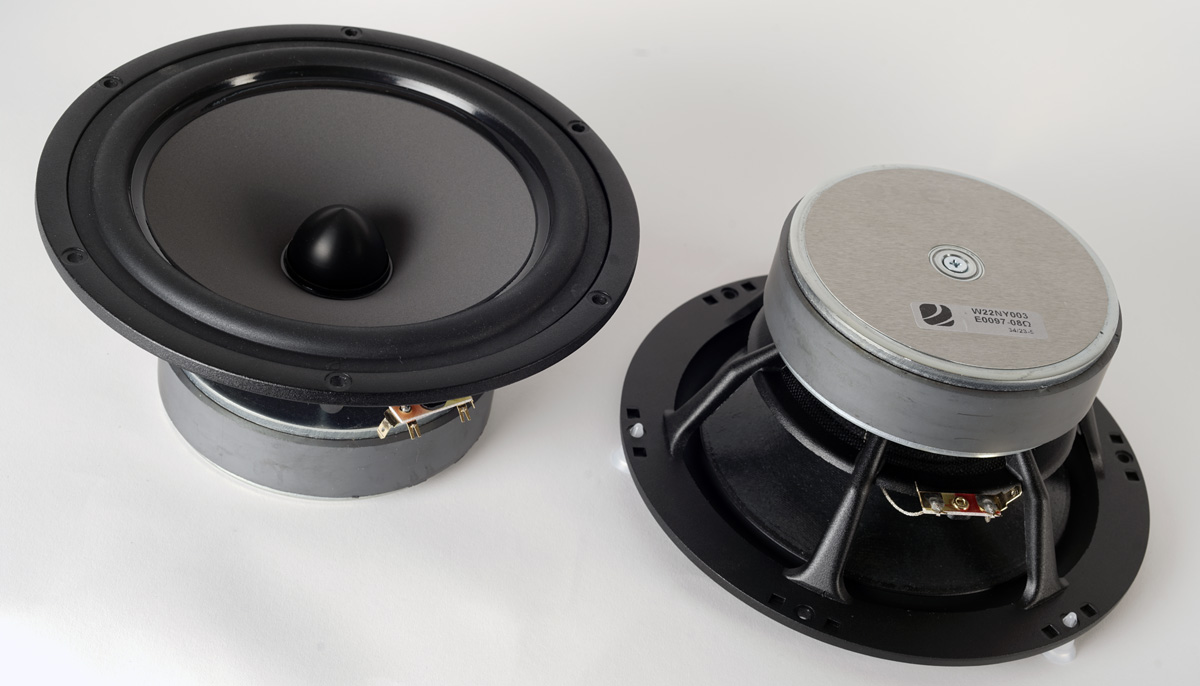
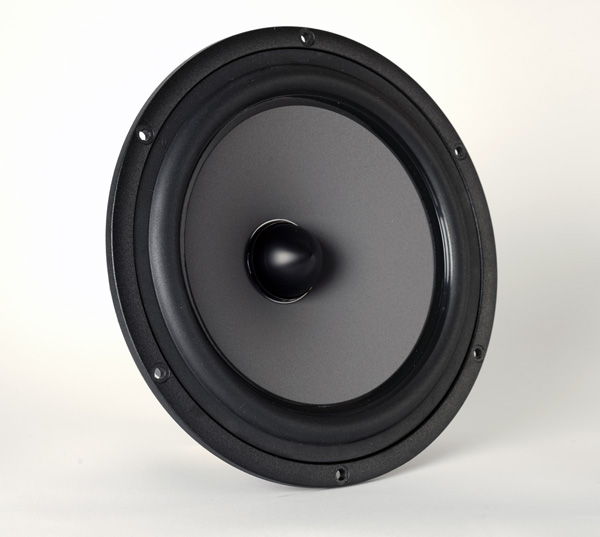

Above the W22NY003 driver.
Download specs
here.

I didn't do a full TS data set, but from
impedance alone we can calculate Qm and I reach ~6.4 on average, a bit
higher than SEAS does. Whatever is right, this pleases me a lot.
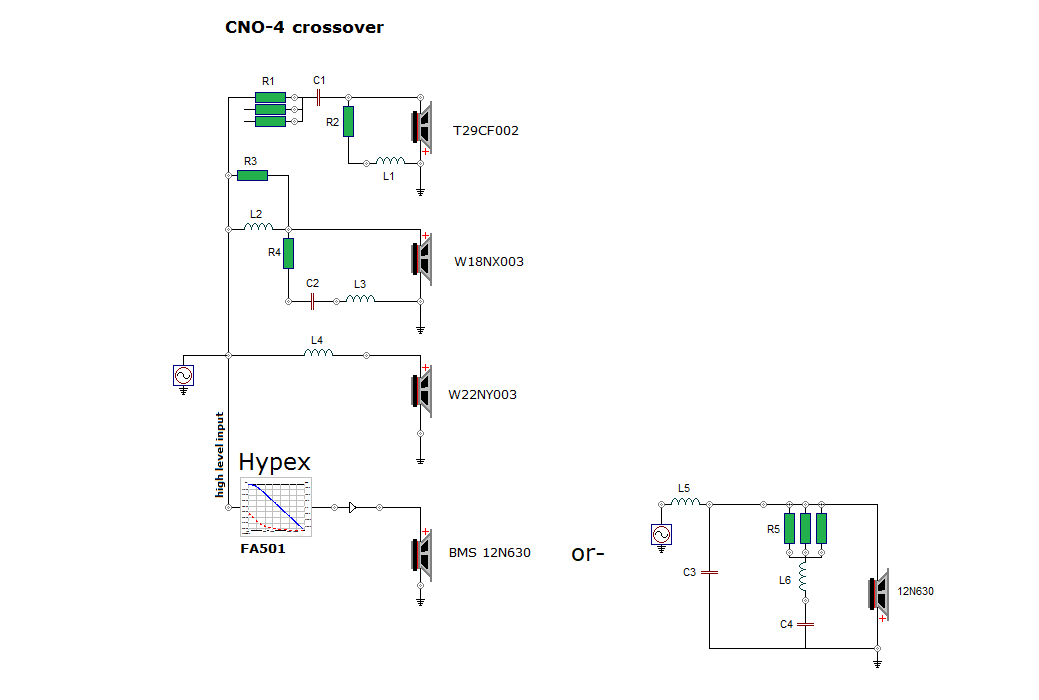
The W18NX003 LCR filter was a late addition as I wanted the W18NX003 to have as
smooth a 1st order roll-off as possible, initially done quite well with
an RC circuit across L2, but an LCR circuit proved just better
technically - and also a little better sonically.
The tweeter circuit may look 2nd order but the value of R2 is very high
and R2+L1 only helps shaping the 1st order roll-off. Several type of
coils were tested for the W18 and W22 and eventually I found the foil
CrossCoils performing very well, so this it will be. C1 can be Alumen-Z
or Amber-Z, the latter seriously expensive. I suggest starting with the
Silver-Z and should you like what you hear, you may later substitute
with Alumen-Z or Amber-Z.
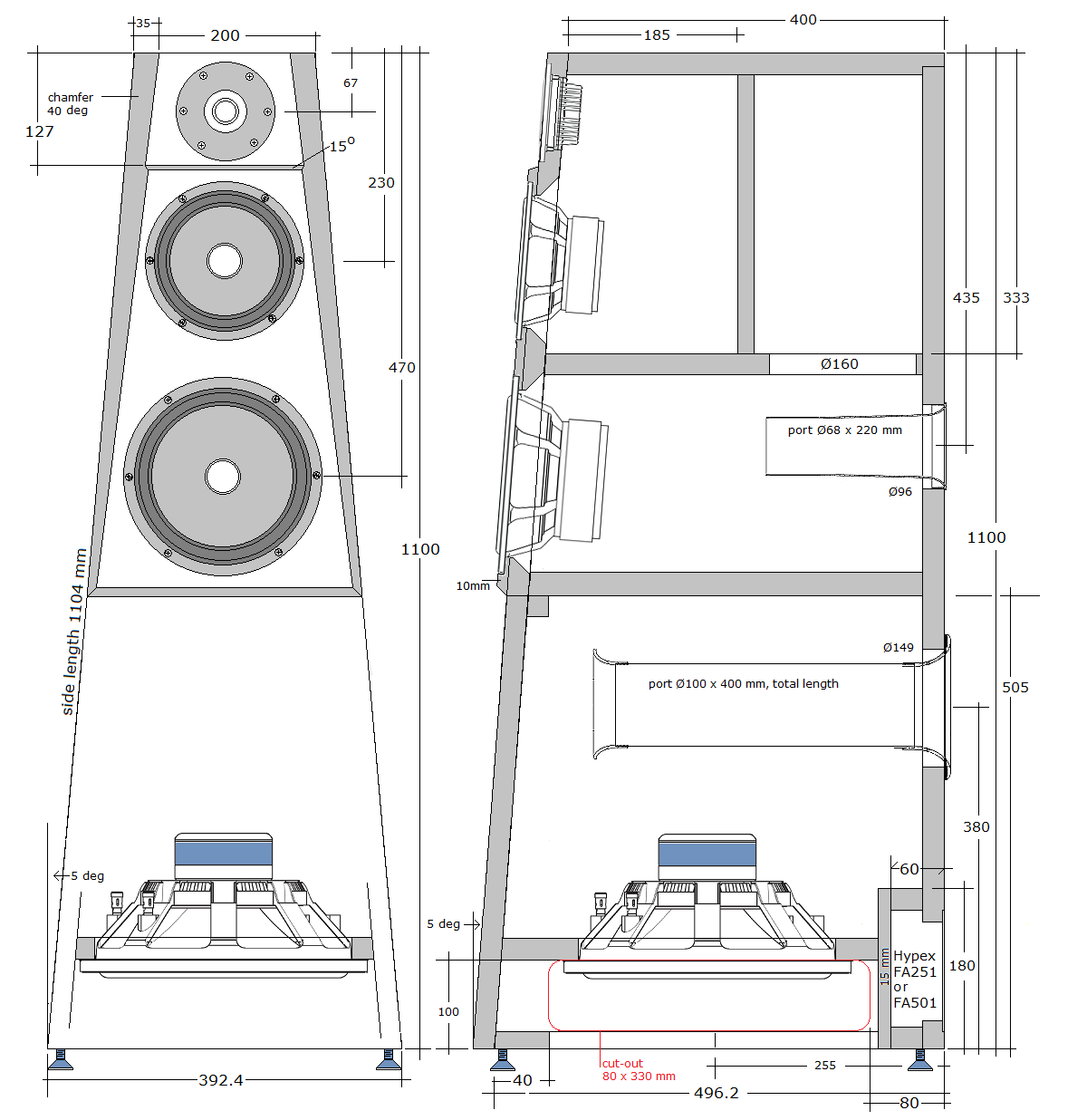
Tweeter is recessed 10 mm and I added a 10 mm panel to the 25 mm basic
front panel. Cut 15 deg. towards the tweeter like seen on drawing.
Cabinets were made from 27 mm Baltic birch. You can use 20-22 mm and add 4 mm bitumen pads without changing any dimensions. The bottom dimensions, width and depth, is the actual dimension based on calculation derived from the actual tilt of sides and front. Make 390 mm width and 495 mm depth and you're fine. The added front panel for W18 and W22 is 10 mm to acoustically align the midbass and tweeter.
Cabinet damping:
Add 8 mm felt sheets to all internal panels except front panel for upper
section.
Add 150 grams sheep's wool to 18W cabinet.
Cut two pieces of 30 x 50 cm acoustilux, roll it and stuff the cavity
behind the 18W driver.
Cut one piece of 30 x 50 cm, fold and place on top of the crossover on
W22 floor and up the sides. See image below.
Bass cabinet: Cut two pieces of 40 x 50 cm acoustilux and place over the
port and down the sides.
Port for W22 cabinet: Ø68 x 220. Roll a piece of 15 x 50 cm acoustilux
and stuff the port with this roll. This makes an aperiodic tuning. What
is this? Read here:
http://www.troelsgravesen.dk/Variovent.htm
Hypex FA251 or FA501 plate-amp/DSP
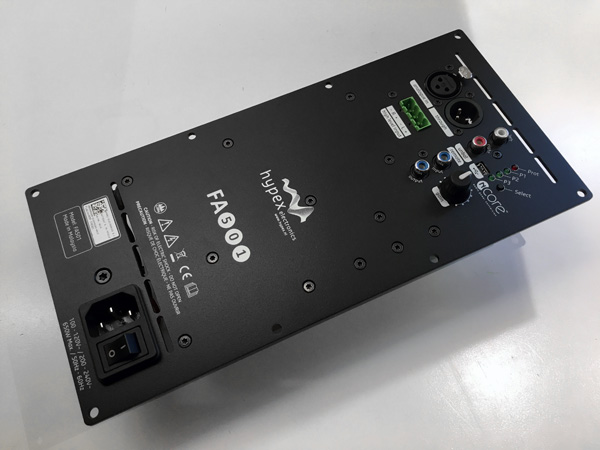
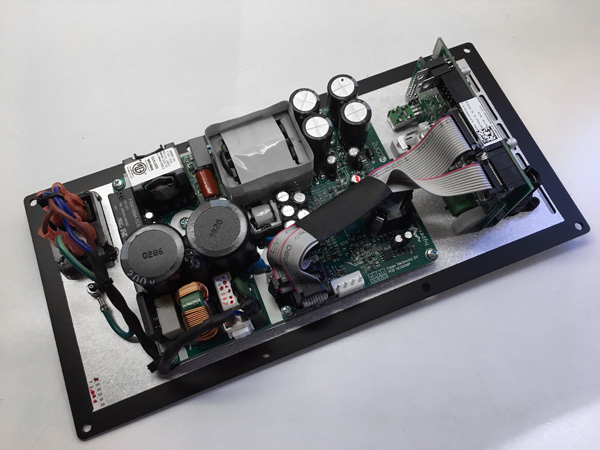
You can use either Hypex FA251 (250 watts/4 OHms) or FA501 (500 watt/4 Ohms) for the CNO-4. I don't recommend either of them, but use FA501 myself knowing 250 watts is more than enough. Take your pick.
Download programs here. zip file.
Go to Hypex page to learn more:
http://www.troelsgravesen.dk/FUSION_FA251_FA501.htm
Here you also find the software for your FA501 module.
The two files.
When opening the Hypex software, HFD.
Set all presets to AnalogueSUB input and volume to 0,0 dB
Press Device settings, and you get this:
You can use the setting above, or adjust to personal preferences.
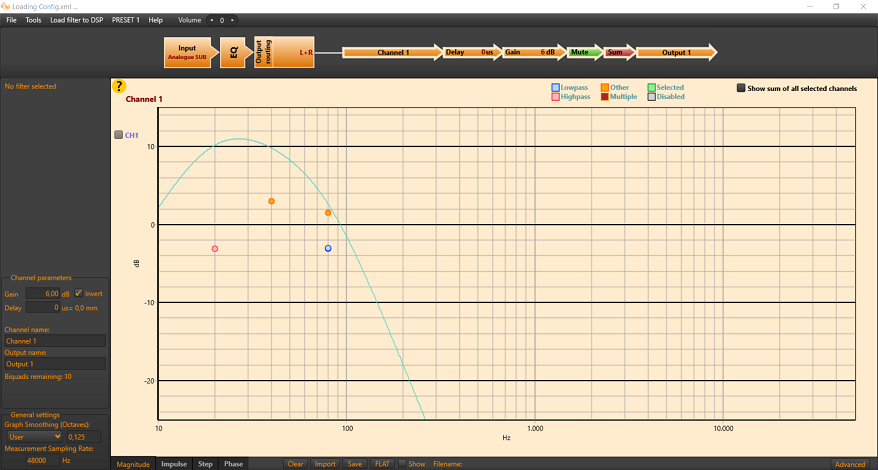
The program when using a high-pass filter for your power amp.
The advantage of using the FA251 or FA501 is that you take the signal
from the speaker cables and do not need a line level source from your
preamplifier in case you do not have such.
The Hypex module contains a DSP, digital signal processing, where the
low-pass crossover for the bass driver is implemented saving crossover
components and ensuring zero resistance between power amp and driver.
Should you for some reason not favour the Hypex solution, there will be a passive crossover for the bass section - but only for bi-amping as the bass section combined with the BMT section will produce an impedance of 2 Ohms, something only a few power amplifiers will be happy with.
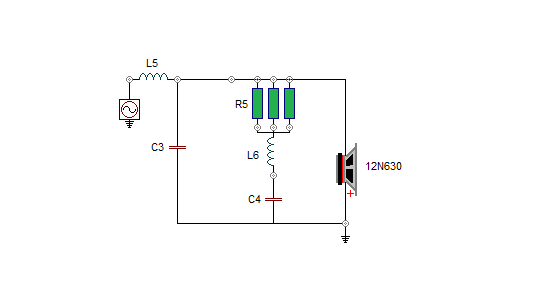
To make a passive crossover working at 80 Hz in a vented box requires
linearisation of the upper impedance peak, thus R5/L6/C4. L6 requires a
heavy high-value C-Coil with a very low DCR of 0.17 Ohm.
It all works very well, but as said, recommended only for
bi-amping.
L6 is a cored coil from 1.0 mm wire and internal resistance of
1.07 Ohm. Capacitors, C4, are MKT caps.
Workshop images
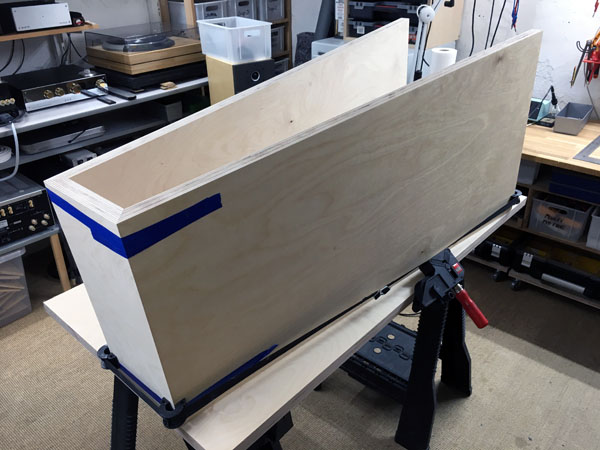
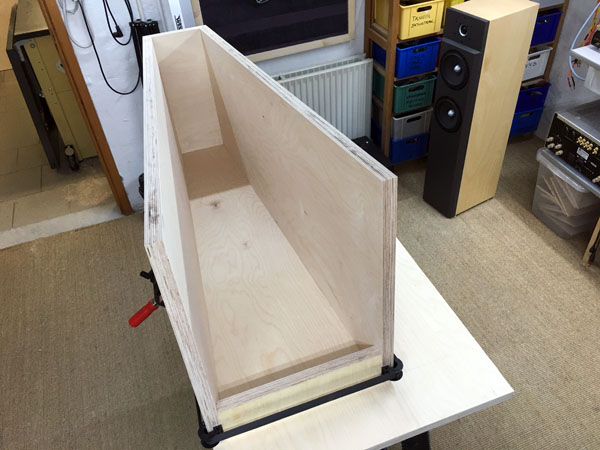
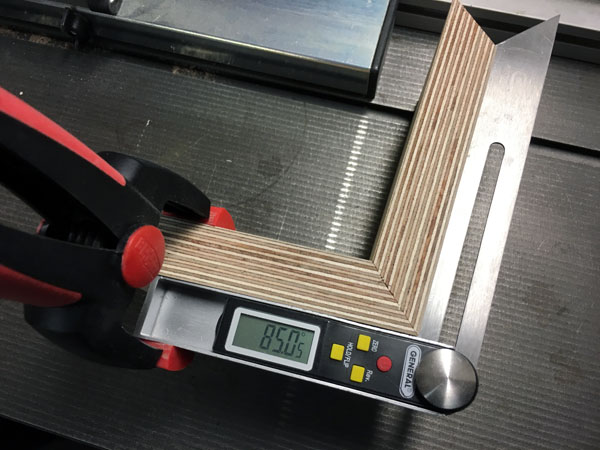
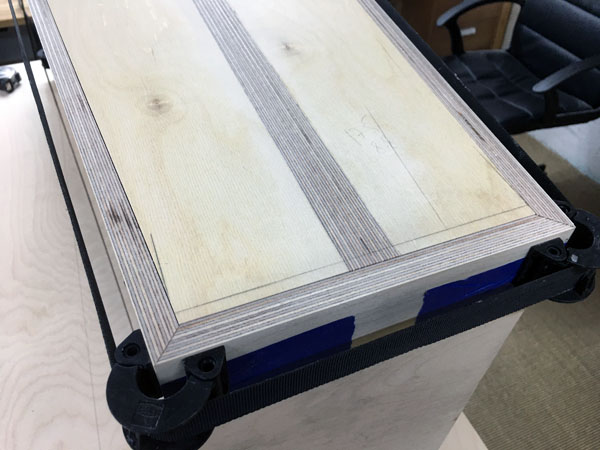
Make test cuts of 42.5 deg. to see if it adds up as expected.
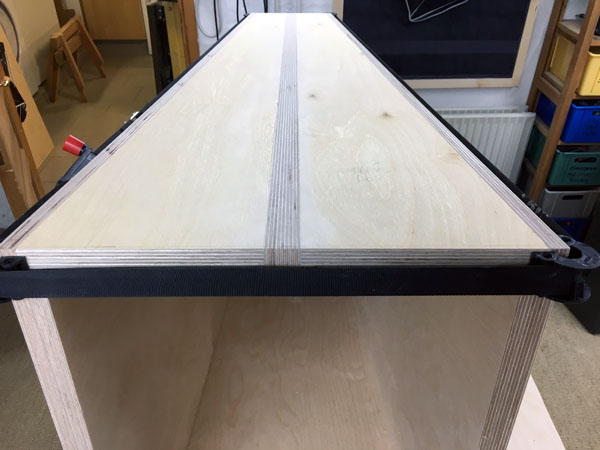
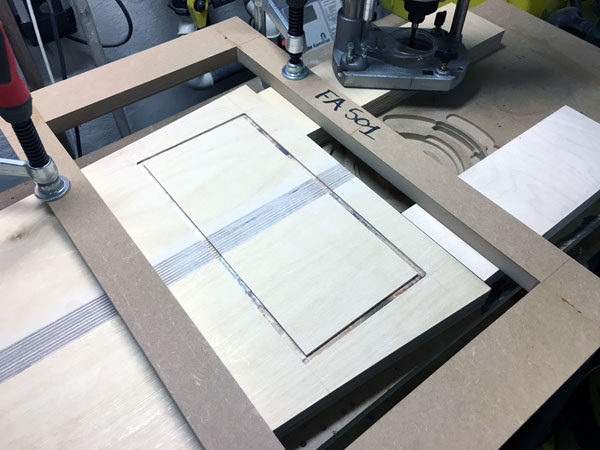
Routing for the Hypex module. This doesn't have to be flush mounted, but
looks nice.
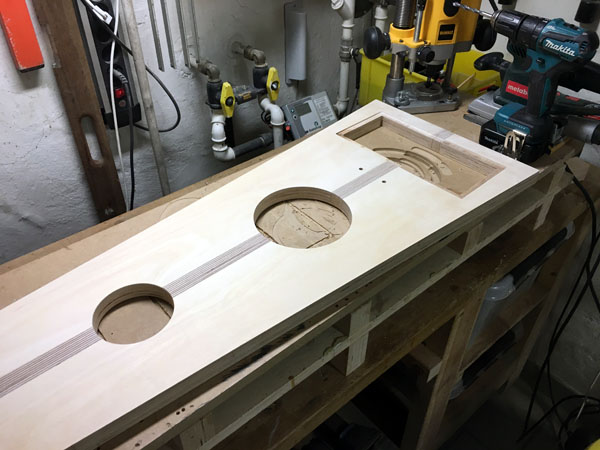
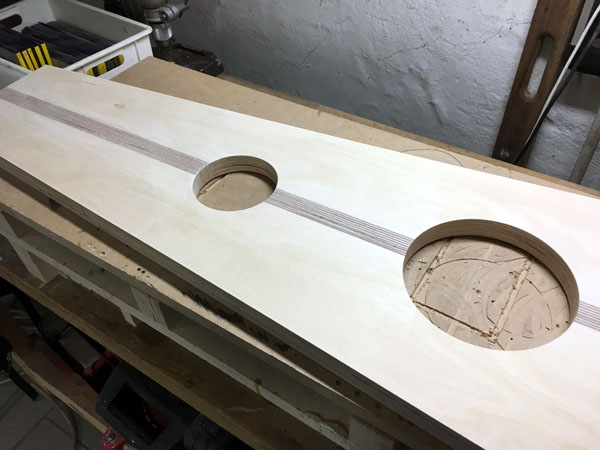
Port holes made.
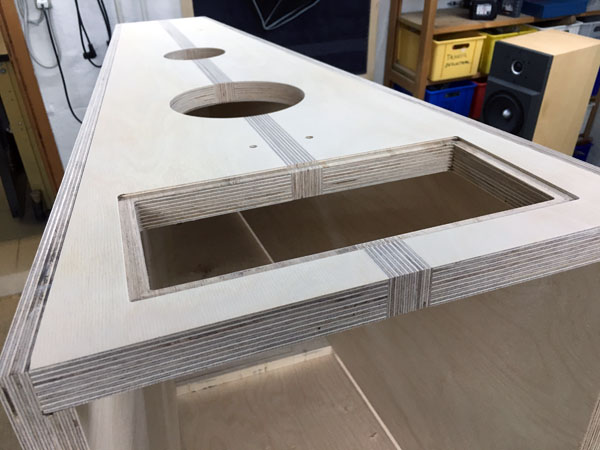
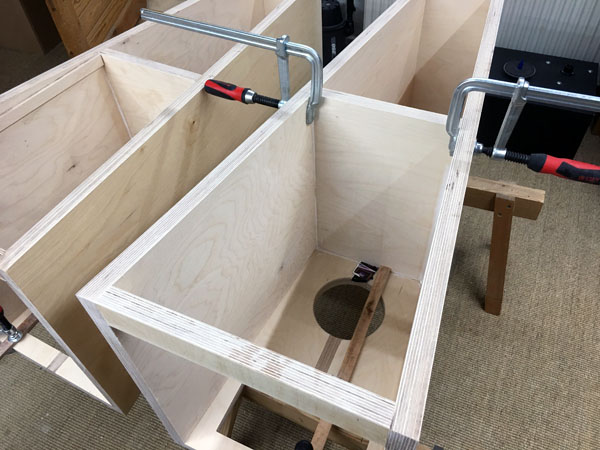
Gluing the bas upper panel.
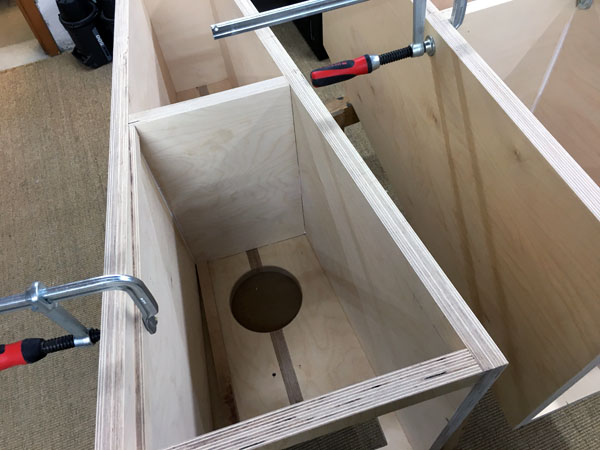
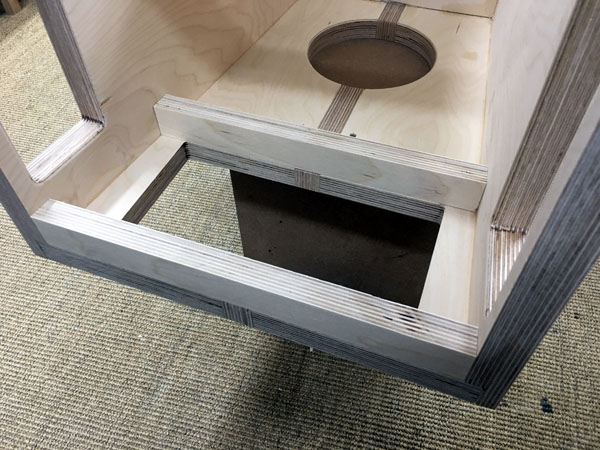
Preparing for the Hypex compartment (right image).
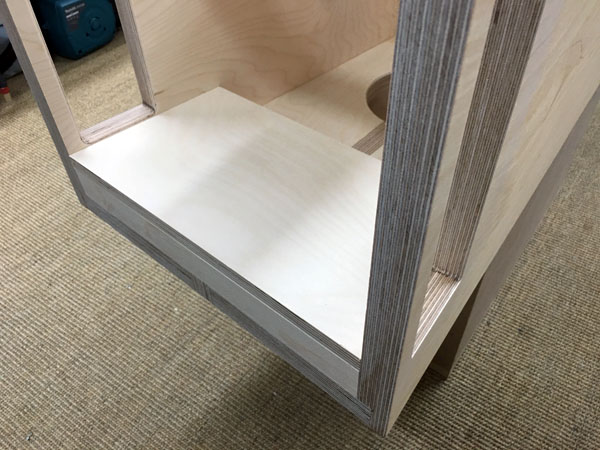
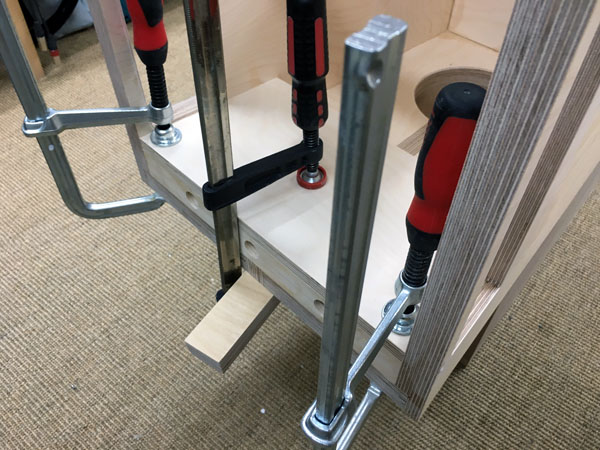
I like electronics to be ventilated, hence three 20 mm holes in lower
panel of Hypex compartment.
The Hypex module has slots on face plate and it should now be properly
ventilated.
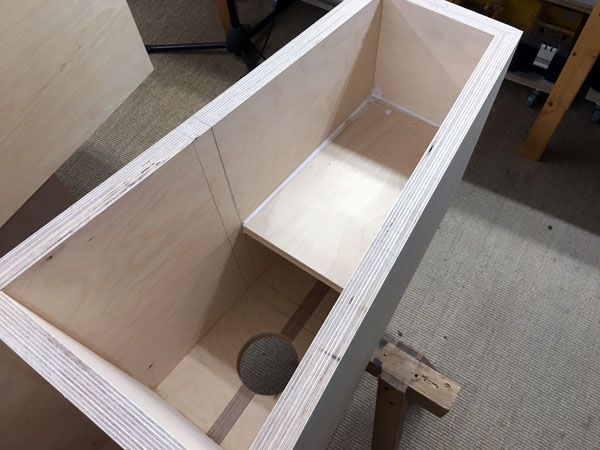
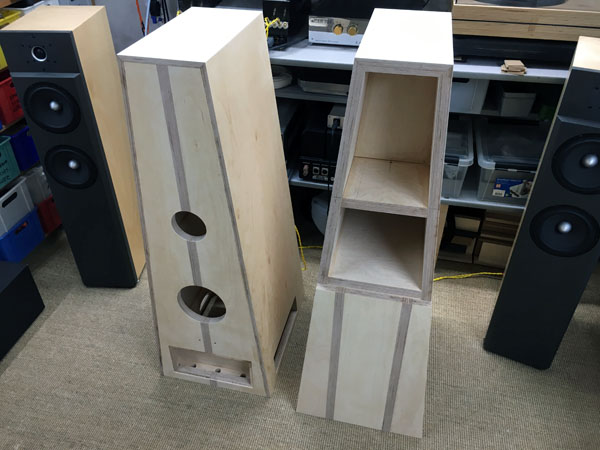
Gluing W18 rear panel in place. Cabs ready for sanding and lacquer
(right).
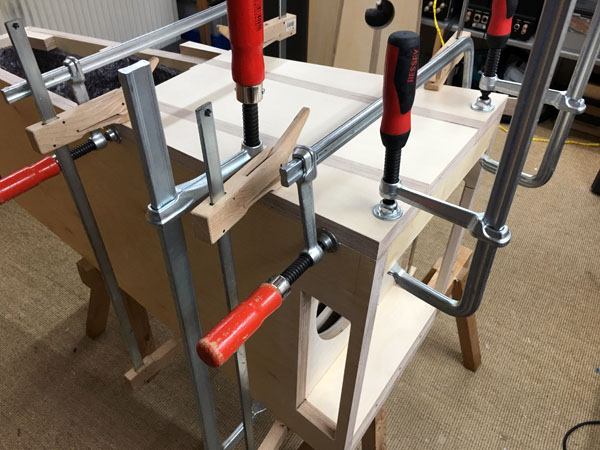
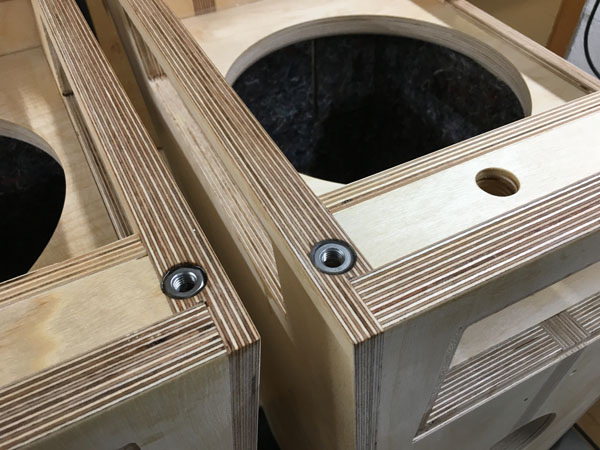
Gluing bass section front panel. Adjustable
feet bolts, M10, glued with epoxy.
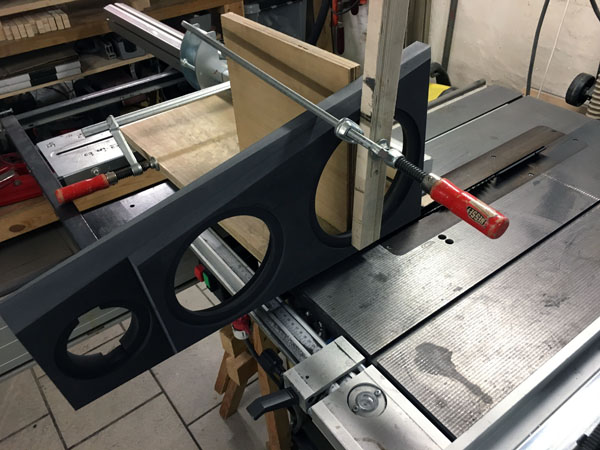
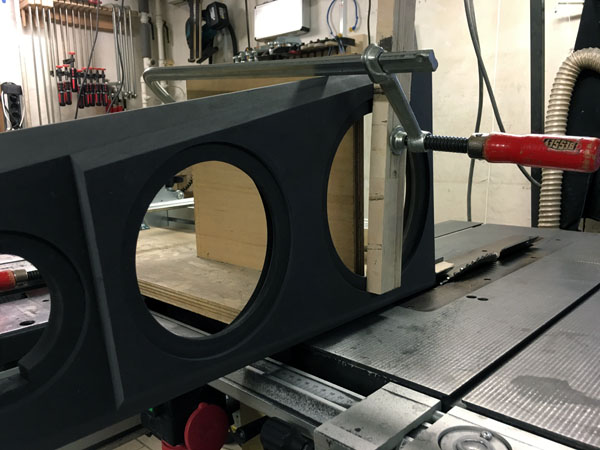
Set the saw blade to 40 deg. and the side slider to ~2 deg. and do the
front panel chamfering.
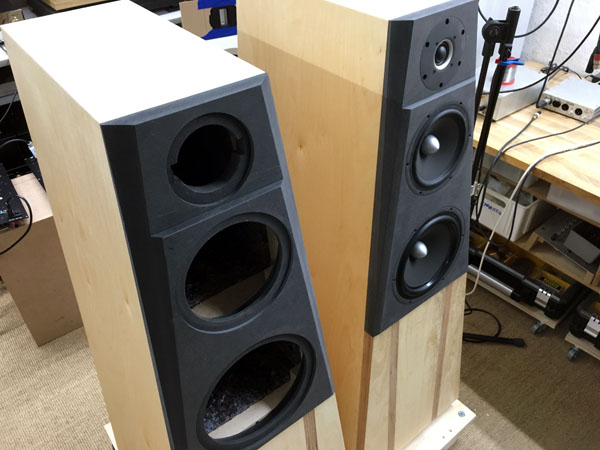
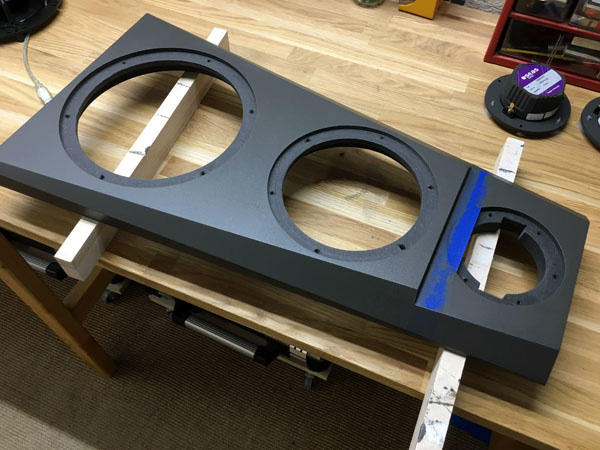
Testing front panels for the T29 version. Front panel at stage in
painting.
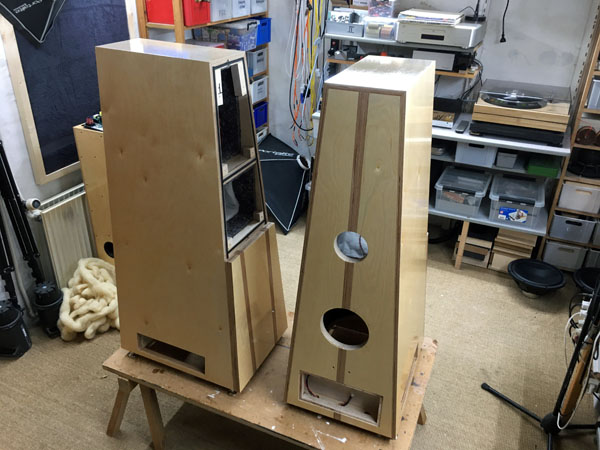
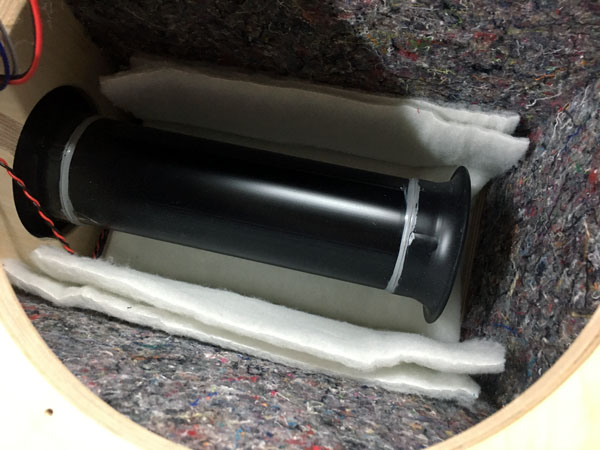
Cabs drying from final 4th lacquer coat. Add two 40 x 50 cm sheets of
acoustilux above port.
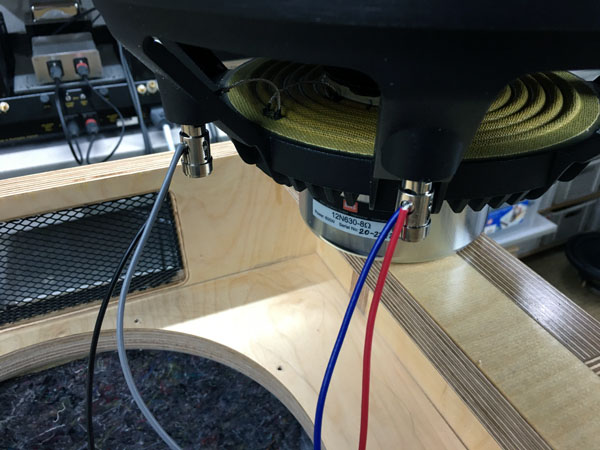
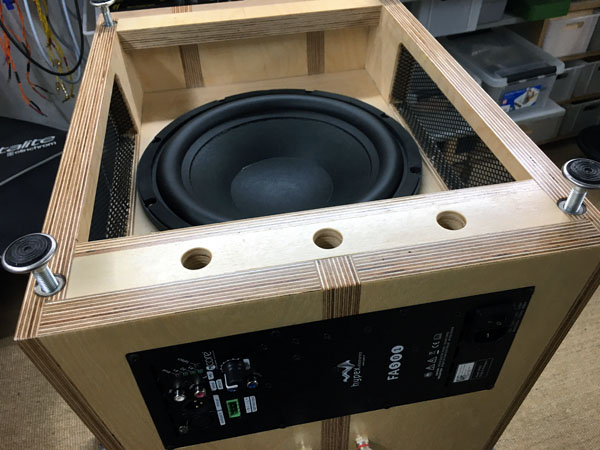
Combine red and blue wires for PLUS and grey and black for MINUS. Bass
section finished.

Workshop set-up.
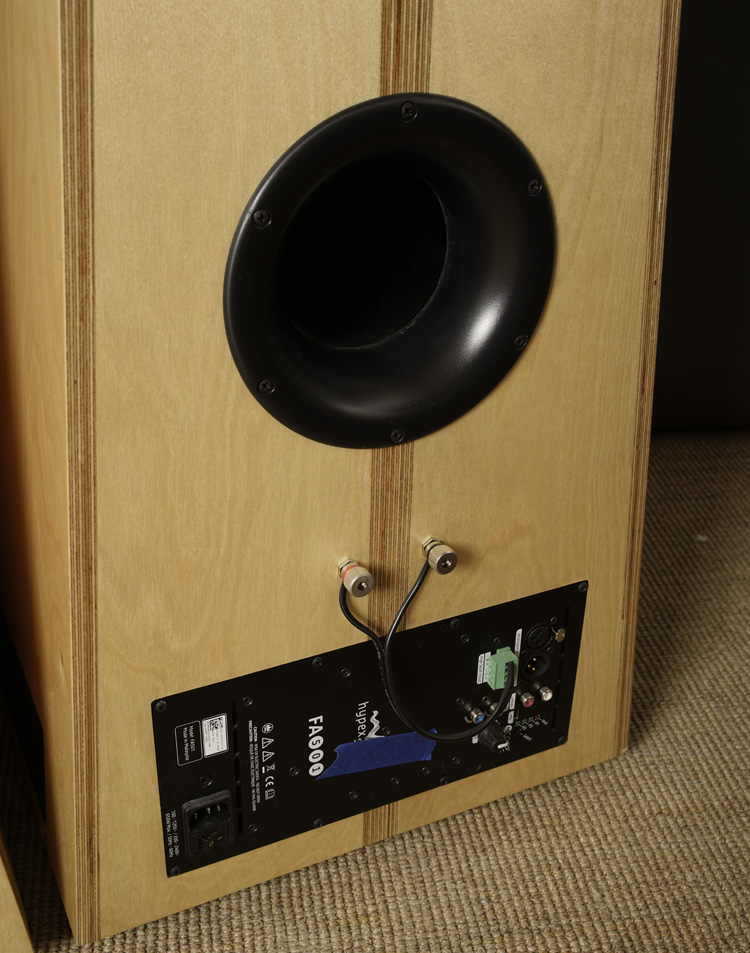
The Hypex connection. As simple as that.
A few comments on
MEASUREMENTS before you start interpreting the readings below.
First of all, if we think measurements will
tell us how a speaker sounds, we're wrong. The perception of sound is
way too subjective to be reflected in any measurements we can perform. A
loudspeaker system is meant to give us a satisfying idea of an acoustic
event and for some people a pair of 5 USD ear-plugs are enough, others
spend 200 kUSD on a truly full-range pair of speakers - and the latter
may not be happier than the former.
Measurements may give us an idea of tonal balance of a system, i.e. too
much or too little energy in certain areas, although dispersion
characteristics play a vital role here. A two-way 7+1 and a three-way
7+4+1 may display similar horizontal dispersion, yet sound very
different. Measurements may tell us about bass extension if far-field
measurements are merged with near-field measurements. In addition to
this, ports may contribute to bass extension. Most of we diy'ers do not
have access to an anechoic room for full-range measurements from
20-20000 Hz.
What cannot be seen is what kind of bass performance we get in a given
room. Bass performance is highly dependent on in-room placement of your
speaker and the same speaker can be boomy in one place and lean in
another. Actual SPL level at 1 meter distance and 2.8V input is useful
for en estimate of system sensitivity and combined with the impedance
profile may give an idea of how powerful an amplifier is needed to drive
the speaker to adequate levels.
What measurements do not tell is the very sound of the speaker unless
displaying serious linear distortion. The level of transparency, the
ability to resolve micro-details, the "speed" of the bass, etc., cannot
be derived from these data. Distortion measurements rarely tell much
unless seriously bad, and most modern drivers display low distortion
within their specified operating range.
Many people put way too much into these graphs and my comments here are
only meant as warning against over-interpretation. There are more to
good sound than what can be extracted from a few graphs. Every graph
needs interpretation in terms of what it means sonically and how it
impacts our choice of mating drivers, cabinet and crossover design.
What measurements certainly do not tell is the sonic signature of the
speaker, because speaker cones made from polypropylene, aluminum,
Kevlar, paper, glass fiber, carbon fiber, magnesium, ceramics or even
diamonds all have their way of adding spices to the stew. Nor do
measurements tell what impact the quality of the crossover components
add to the sound, from state of the art components to the cheapest of
coils and caps, they all measure the same if values are correct, yet
sound very different.
Measuring a 2½-way speaker with 1st order crossovers is quite a
challenge due to inherent crossover lobing, something that can only be
done at far distance in an anechoic chamber - and I haven't got one.
Below you find the summed response of bass and midbass drivers, tweeter
and summed response of midbass and tweeter.
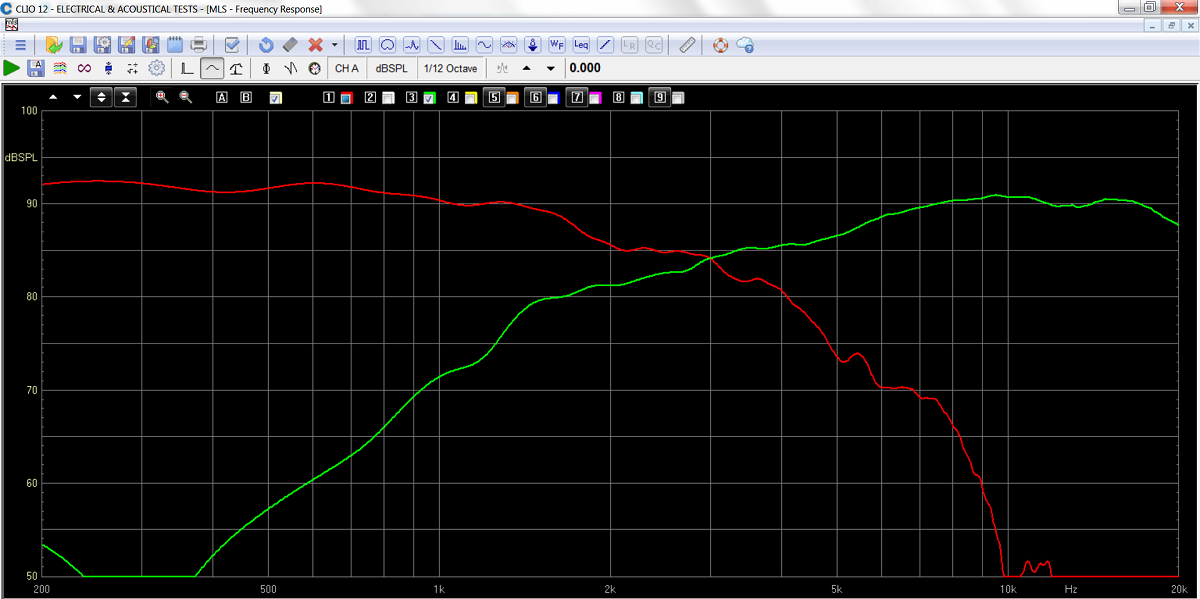
Red: Summed response of W22 and W18 drivers driven from crossover.
Green: T29 response driven from crossover.
As can be seen we have some 91-92 dB sensitivity from running the W18
and W22 in parallel.
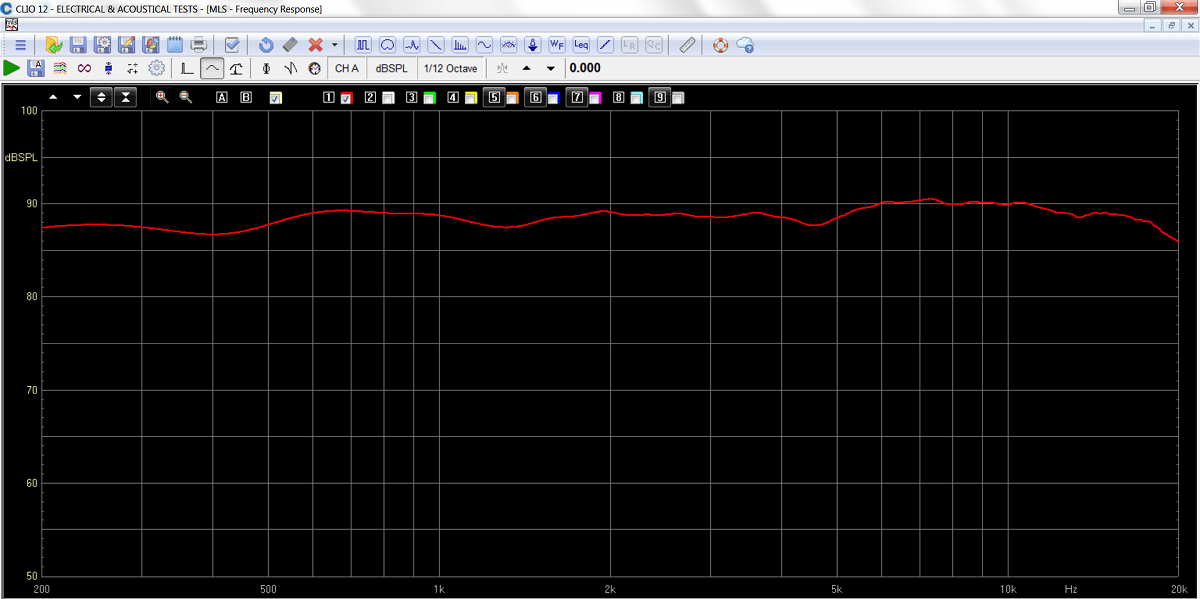
Summed response of T29 and W18 drivers driven from crossover.
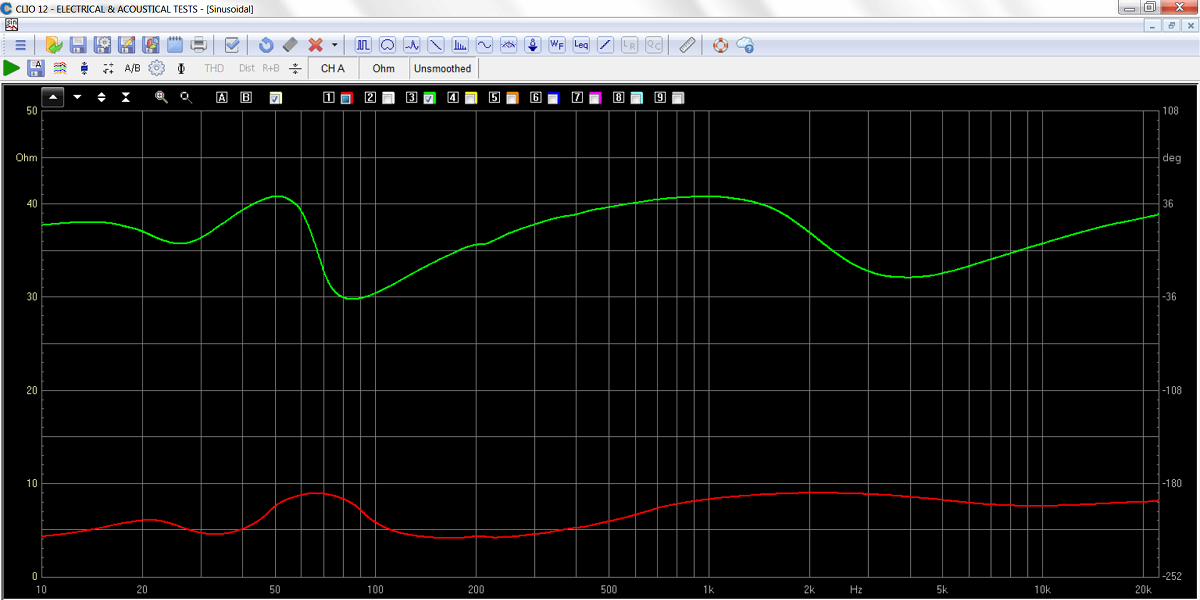
Final system impedance of W22/W18/T29. Talk about an easy load!
Minimum impedance 4 Ohms. Green = electrical phase.
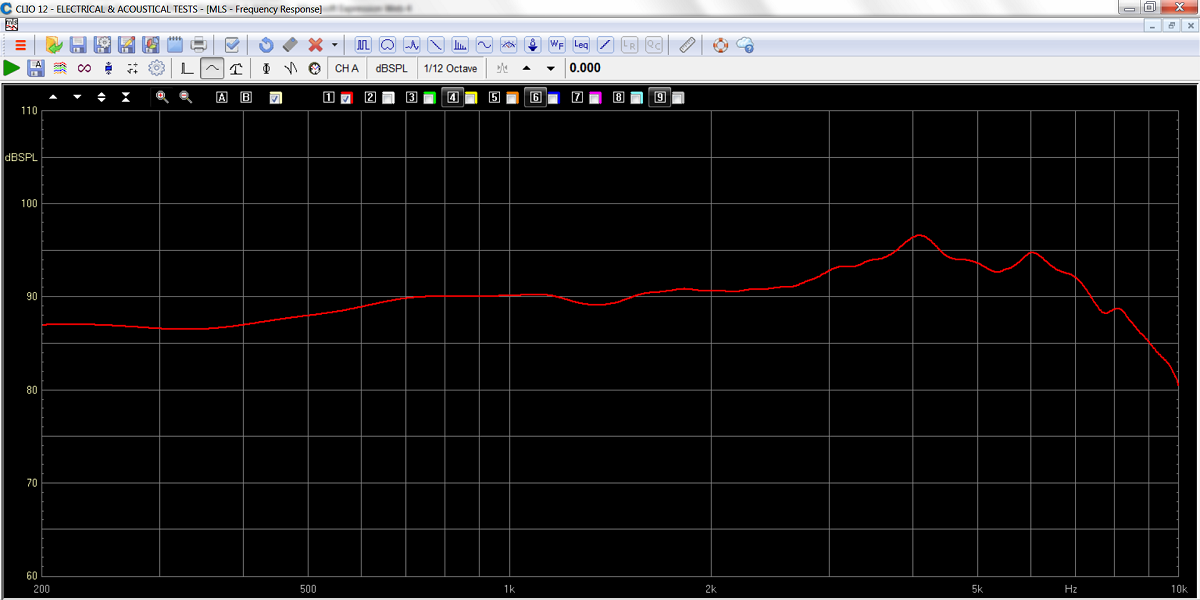
Above the unfiltered response of the W18NX... driver in actual cabinet.
In all of the ever so important midrange - as smooth as one can hope
for.
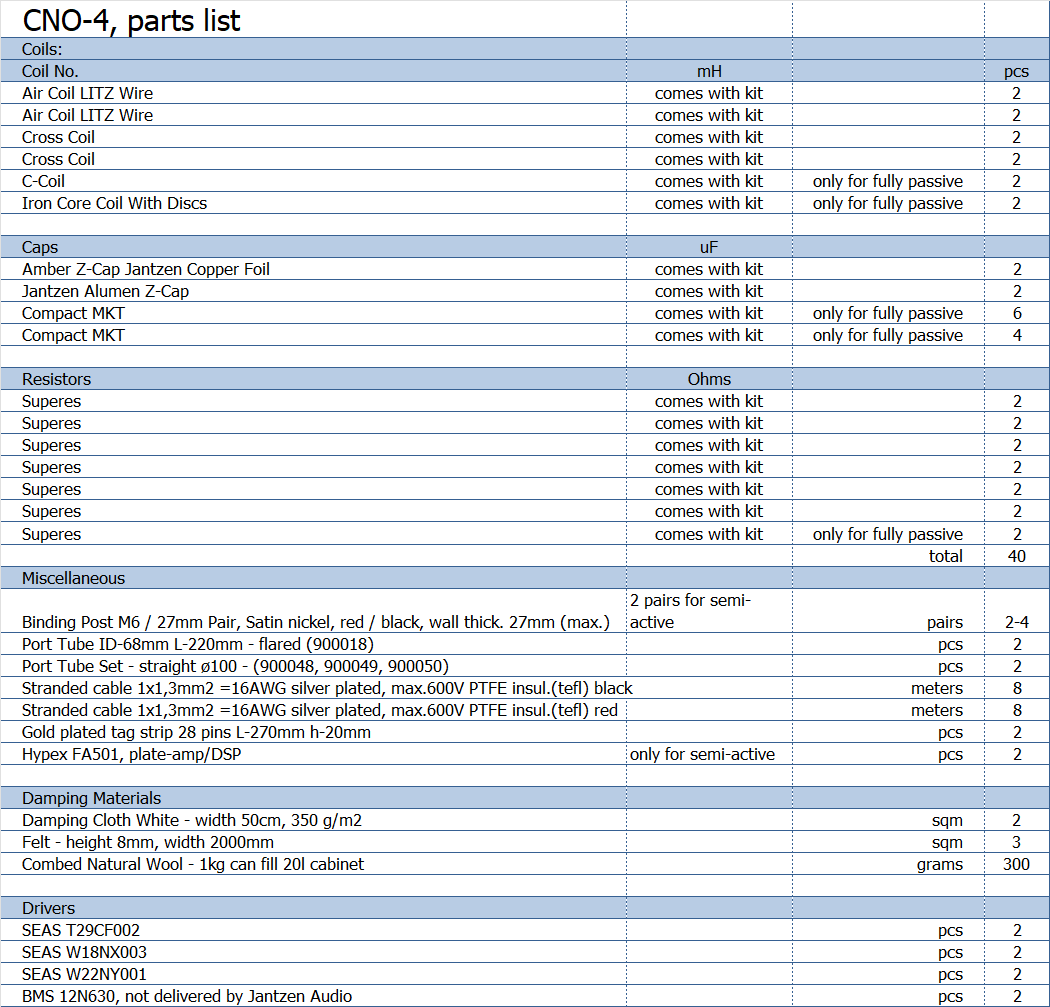
Above the level 1 parts list. For Level 2, the Amber-Z is replaced by
Alumen-Z. This is the only difference.
Pay notice some components are only for the fully passive version.
All kit and component prices may be subject to change and are always to be confirmed by Jantzen Audio Denmark.
Download Kit Sale Presentations:
All technical questions to troels.gravesen@hotmail.com
All questions regarding purchase of
kits, please mail Jantzen Audio at
contact@jantzen-audio.com
CROSSOVER-LAYOUT
BACK TO INDEX
Check this out before start making crossovers:
http://www.troelsgravesen.dk/tips.htm#CONSTRUCTION_OF_CROSSOVERS
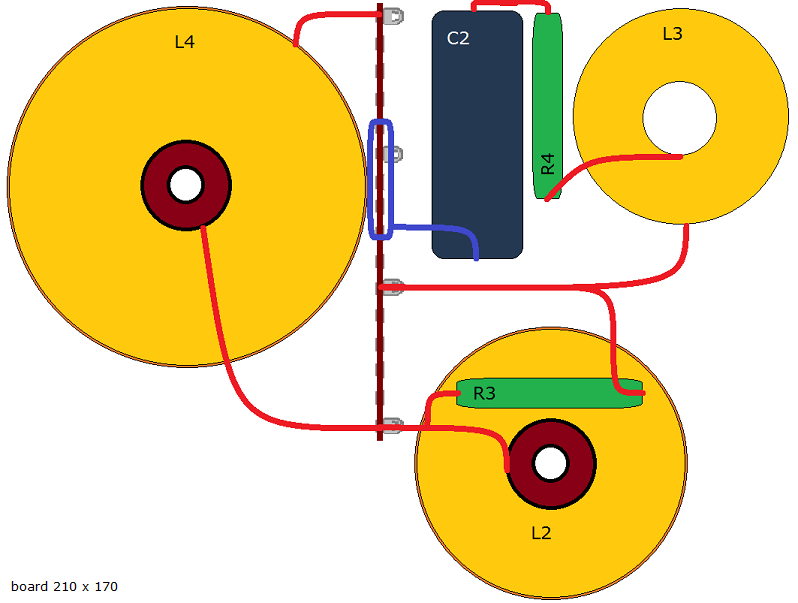
Crossover layout for W18 and W22 drivers.
Place crossover behind W22 driver as close to rear panel as possible.
The width is 225 mm and should fit perfectly with the width at the base
of the upper pyramid with felt damping in place.
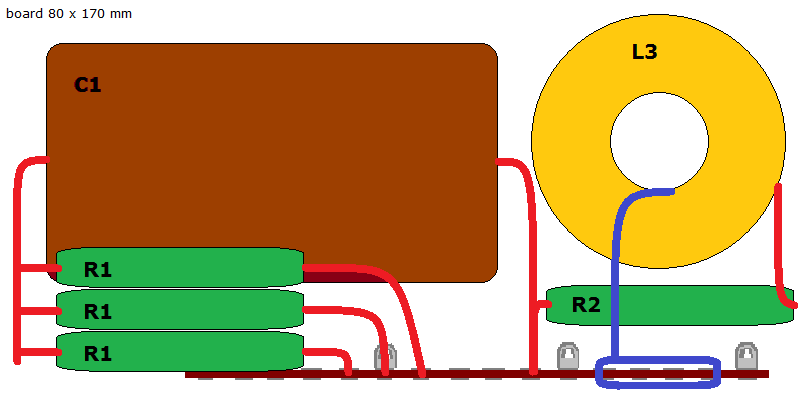
Tweeter section layout. I suggest placing in upper W18/T29 cabinet
behind tweeter to get as far away from driver magnets as possible.
Use half a solder tag strip for each section.
All three attenuation resistors shown here. Connect the input wire to
preferred attenuation resistor.
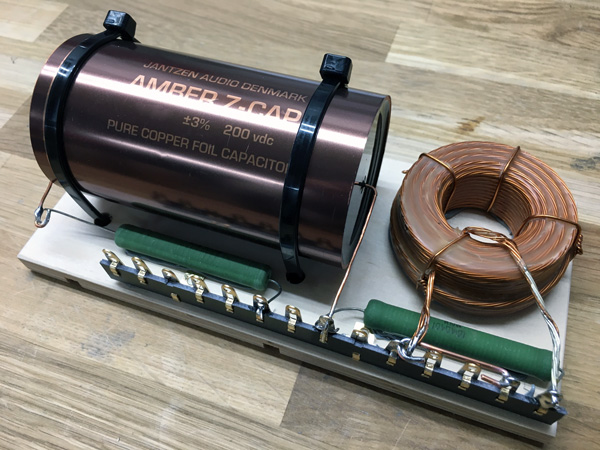
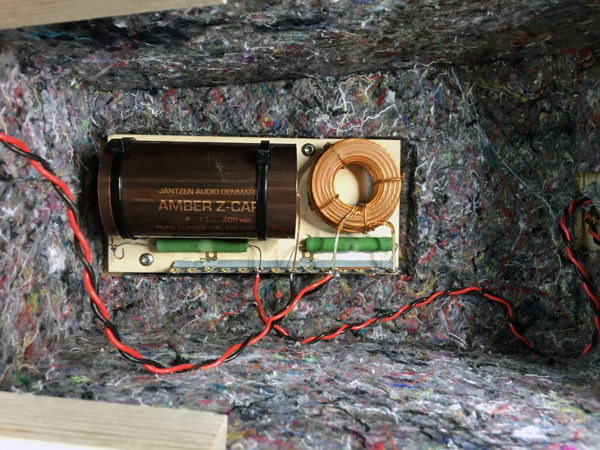
Tweeter section. Click images to view large.
Place tweeter crossover in upper compartment (mid + tweeter) on rear
panels towards top.
Only one attenuation resistor shown here.
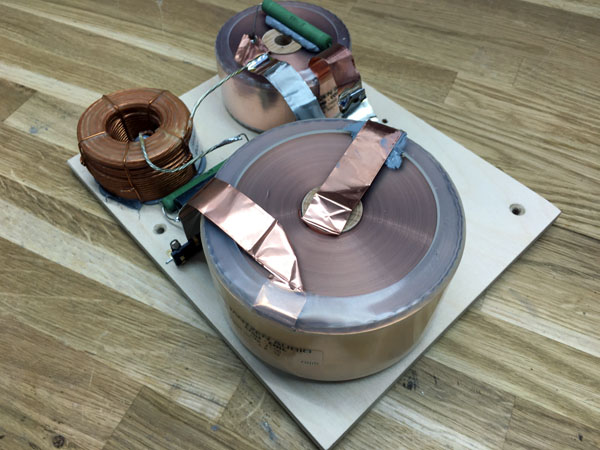
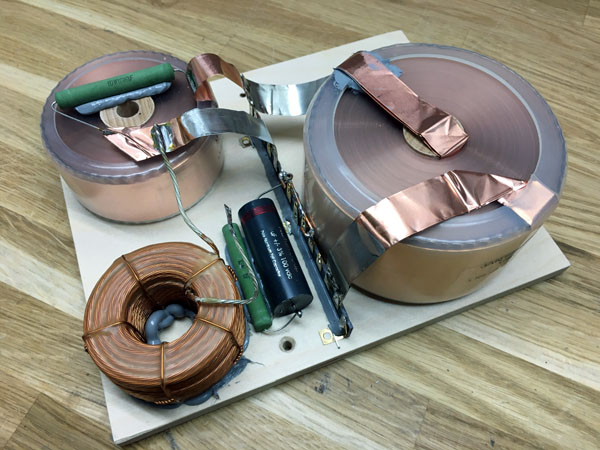
W22 and W18 section.
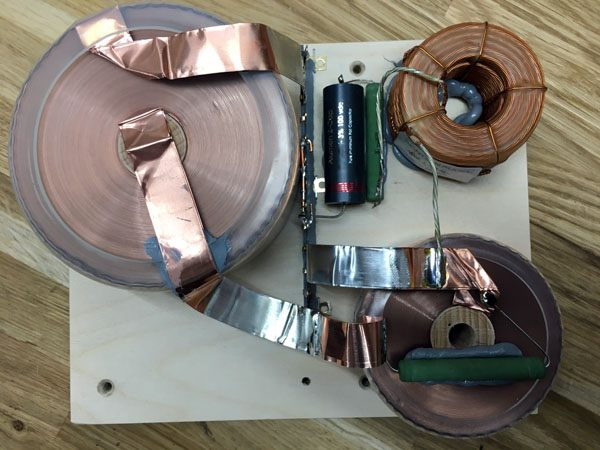
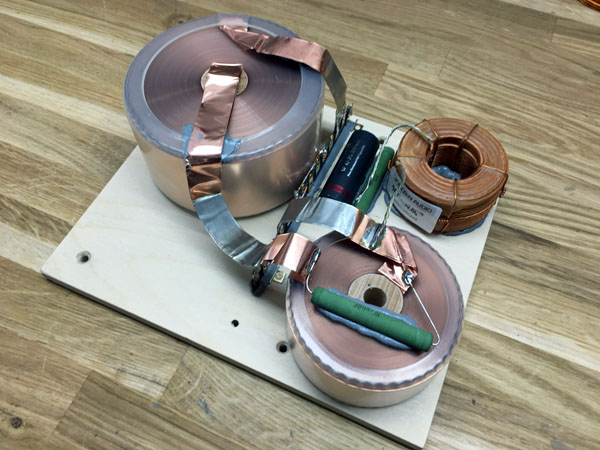
This board now weighs some 3.55 kgs (7.8lb)!
Fasten the chunky foil coils with brass screws.
More info
here on heavy coils.
Speaker wiring
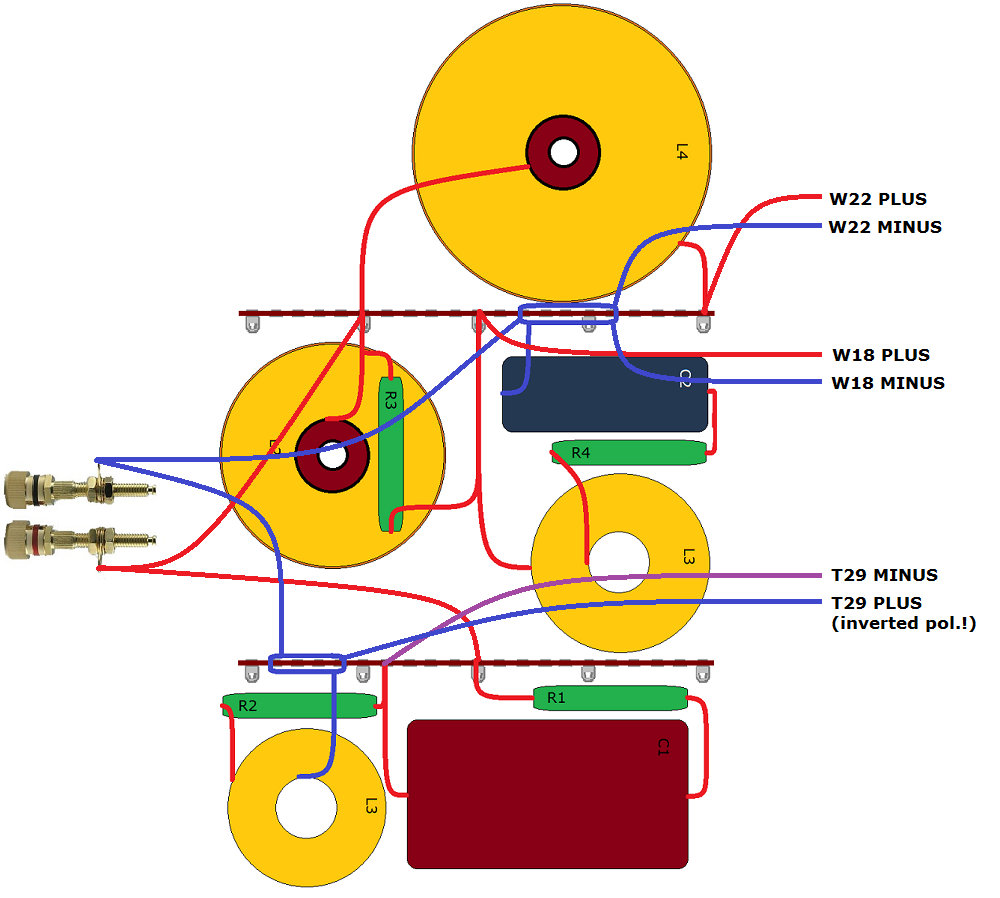
Bass crossover - only for bi-amping:
(fully passive version)
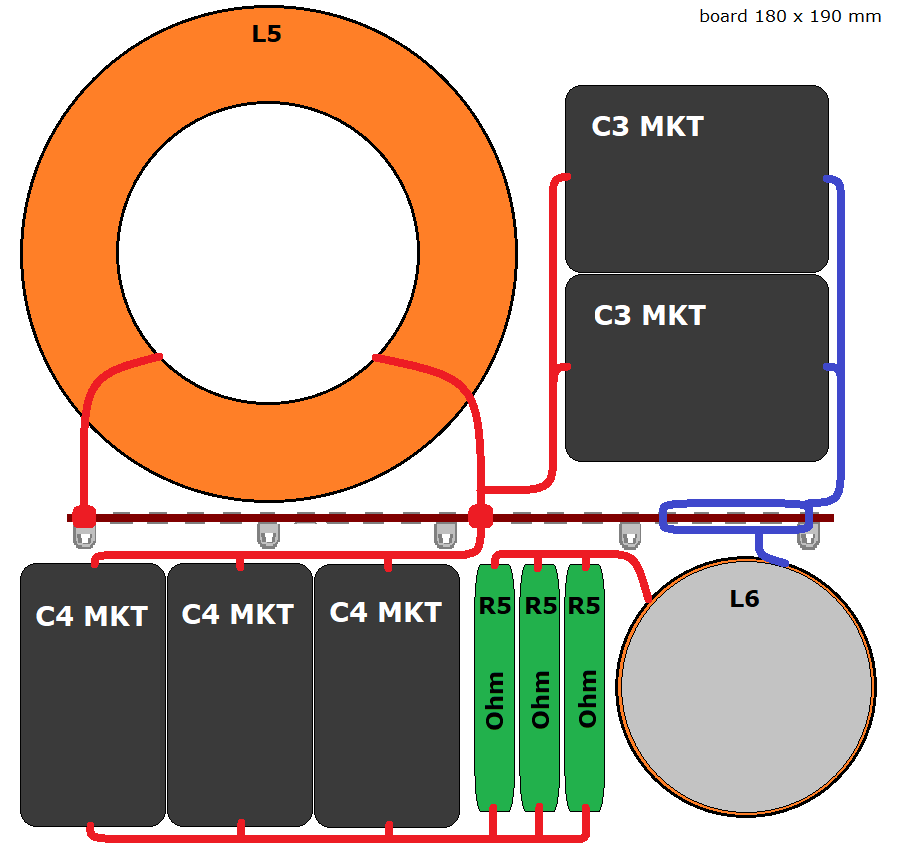
Passive crossover layout.
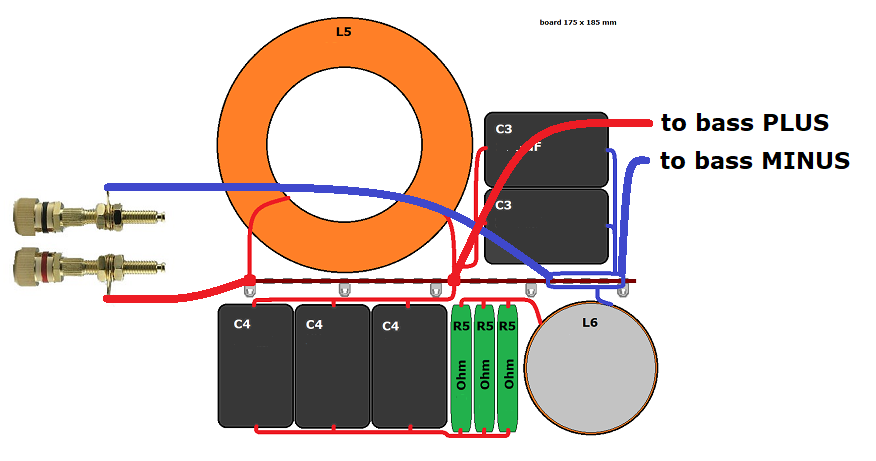
Bass wiring for passive crossover.
